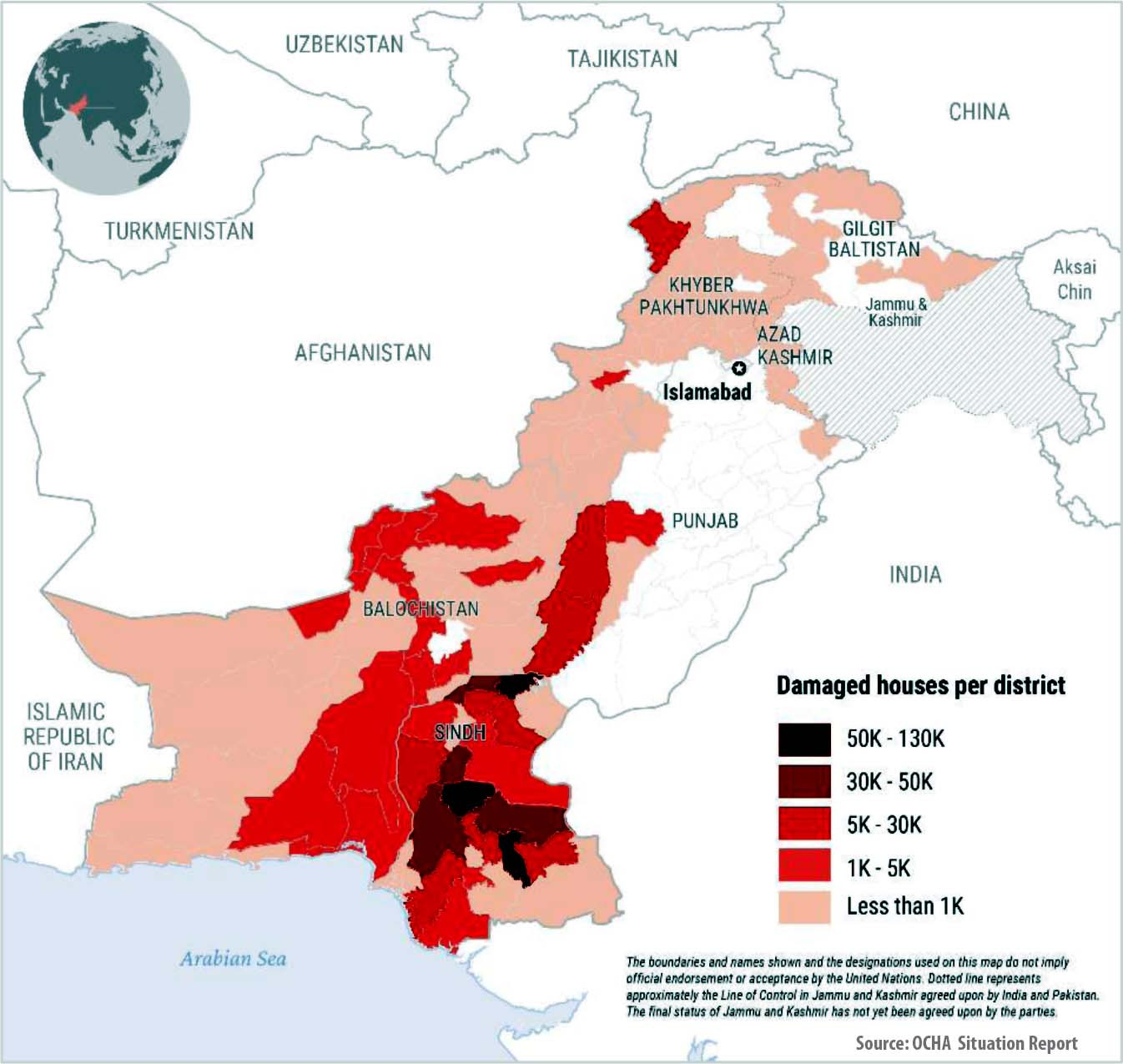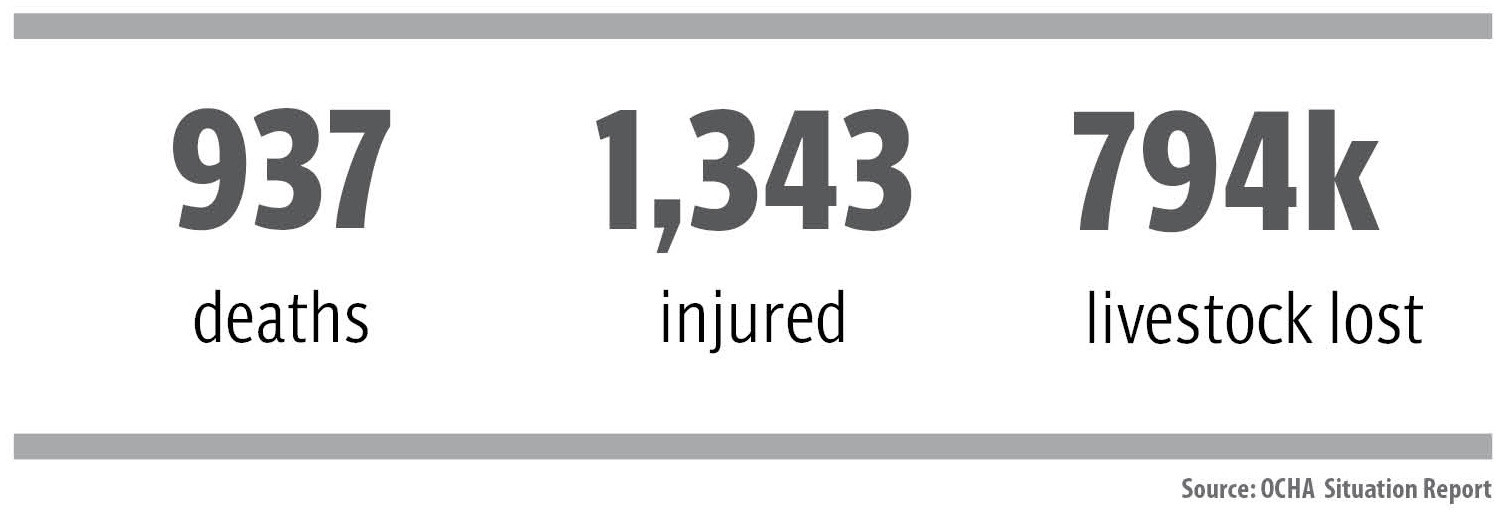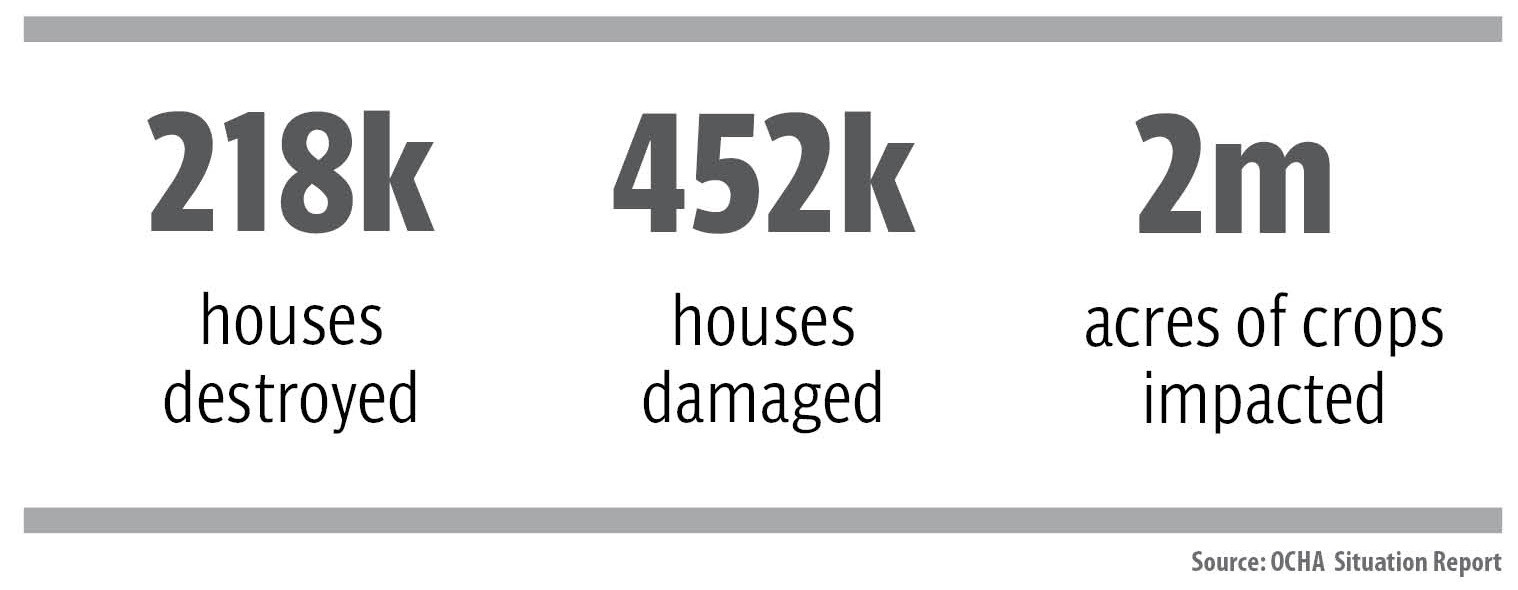Everything is gone. No crops. No food. No drinkable water. And no home. It is an unseen and unimaginable disaster. Floods of Sindh in 2022.
“Fear prevails everywhere,” Yasir Pechuho of village Pechuha says, trying to control his emotions while sharing the details of destruction in his village. Pechuha is in district Kamber-Shahdadkot, approximately twenty-one kilometres from the Larkano city, and has 681 houses. Half of the houses are fully damaged while the remaining ones have also been affected. Pechuho says that 351 houses collapsed in the last one week. “Only a few families now have the courage to stay inside their homes. The elders keep their eyes open as they feel that their shelters are unsafe now.”
Barkat Meerani, another villager, asks, “Where should we go? There is no other way. Water has submerged everything, including roads.” Sharing the overall situation, Meerani is of the view that no one in his village has ever witnessed this kind of massive destruction. “It is not only our village that has been destroyed but almost all villages in the area.”
Altaf Pirzado gets emotional when talking about the destruction in his village Balreji, known as “Little Moscow” because of political activism and literacy rate. “Not a single home is fit for living, almost eighty percent houses are partially or fully damaged.” He says that the houses his relatives feel are still safe will also collapse, “They are going to collapse sooner or later as mud houses cannot survive in or after continuous rains.”
Pirzado’s village is located on the right bank of the Indus River near Moen-jo-Daro. He says that the government machinery did not respond, and it was too difficult for residents to pump out the rainwater.
The situation is almost identical in all twenty-three districts of the Sindh province; last week, the provincial government declared all these places calamity-hit after continuous rains happened across the province. According to the Pakistan Meteorological Department, Sindh has received about 400 percent times more rain than it has received in the last few years.
“Over 70 percent houses have been partially or fully damaged,” says Ishaq Tunio, a resident of Thorhi Bijar, a village in Kamber-Shahdadkot. He says that the recent rains have caused large scale destruction in several districts, “Look at Larkano, Khairpur or even lower Sindh’s Badin district. All are submerged.” Tunio says that in Sindh, especially in hot areas of upper parts, people construct mud houses. “They are made of unbaked bricks and mud and cannot sustain these heavy rains.” His village, like the others in his district, has received uninterrupted rains since July 4. “Sometimes, it rains for forty-eight hours, and after a gap of a few hours or a few days, it again rains for thirty hours,” he says. Out of the eight hundred houses in Tunio’s village, sixty percent are completely damaged, but his own house that was built a couple of years ago is still safe. “It could fall if rainwater enters the village,” he says.
Sindh CM’s Advisor for Rehabilitation and Relief Haji Rasool Bux Chandio says that his department is trying to get the exact data of the rain related destruction. “This is the worst situation, and I do not think these mud houses in rural areas could sustain more rains,” he says.
Displacement is huge, and in rural areas, thousands of people, along with their livestock, are seen living on roads. They barely managed to bring only a few of their belongings. Being disconnected from the main cities, most of the displaced families are unable to arrange tents. Most of the areas along the Indus River and far-flung villages are under water.

Ghulam Mustafa of Kazi Ahmed of district Nawabshah says that in the heavy rains of 2011 and 2012, families had the option to take shelter on roads or to move to cities like Sukkur, Hyderabad, and Karachi. “Roads are under rainwater this time. Due to unviability of transport, people cannot even move to the major cities.” Some of his relatives who predicted more rains have already shifted to safer locations.
Like in every monsoon season, government buildings, especially schools and colleges, are being used by displaced families in different areas. “There is no other way but to take refuge, which is only possible in government buildings,” Mustafa says, adding that the relief camps set up by government lack facilities but are safer than partially damaged houses.
Speaking to The Express Tribune, Sardar Sarfaraz, chief of Pakistan Meteorological Department, says that Pakistan, overall, has received 190 percent more rains than average. “In 1978, almost the same kind of situation was recorded in Balochistan, Punjab and Khyber Pakhtunkhwa.” Sarfaraz says that his department informed the government about the impact of this year’s monsoon rains. His department does not forecast rains for at least one week, but he warns: “I cannot say the danger is over now.”
Another senior official from his department, on the condition of anonymity, says that the provincial as well as the federal government were informed about the rains. “They did not take precautionary measures in advance,” he says. He also points out that houses in rural areas and slums of major cities are not safe if rains continue.
Professor Dr Imtiaz Ahmed Chandio, Chairman of the Department of City and Regional Planning, Mehran University of Engineering and Technology Jamshoro, says that houses in small towns and rural areas are not fit to sustain these heavy and continuous rains.
“Those that have survived can also collapse after rains. Accumulated rainwater in villages and towns has damaged the foundations of houses. Walls and roofs are weak now and will cause more damage in coming days,” he adds.
There is a lack of town planning in Sindh,” Professor Chandio says, adding that neither common people nor the government was ready in advance to face such a disaster. “We do not have modern construction that is fit for any kind of natural calamity.” He says that there is not concept of soil testing in Sindh, “Foundations are mostly weak.”
Professor Chandio suggests that due to climate change in the region and unprecedented rains in coming years, government needs to introduce hut-style houses. “We also need to have proper drainage system even in small villages. Town planners will have to consider how a better system can be implemented to avoid more devastation in future.”
Urban planners and environmentalists say that the water table in Sindh has increased during the monsoon season. Only those houses will survive that are constructed on proper sites.
Ronaq Behan from Pali Behan of Taluka Thari Mirwah of district Khairpur says that each house has a sad story. “I do not see any village in my district safe from this disaster. Everything is submerged. We all live in water now. There is not a single foot of dry land left. We are trying to buy tents from Hyderabad and Karachi as it will not be a wise decision to live in damaged houses now. There is an acute shortage of even plastic covers.” Poor people can only afford plastic covers to keep their kids, elders, and women safe from rains, but Behan says that even those are very expensive now. “We used to buy it at the rate of Rs. 250 per kg, and now it is being sold at Rs. 1,500 per kg.
This year’s monsoon season started on July 4 in Sindh, and with a gap of a few days, it has been continuously raining in different districts.
After visiting fourteen districts, CM Sindh says that he has never seen this kind of a situation. “Our cities, villages and roads look like a river,” he says. He has also appealed to philanthropists and influential persons to help the flood victims.
Chairman of Pakistan People’s Party, Foreign Minister Bilawal Bhutto Zardari have also visited a few districts, along with Sindh CM and other party leaders, and have instructed the provincial government to utilize all resources during the crisis.

“I do not agree with the government data,” says Mohammad Toheed, an urban planner. “It is a huge destruction, and the authorities cannot estimate accurate figures during rains.” Toheed adds that the recent torrential rains have wreaked havoc on the rural areas of Sindh and Balochistan provinces, with only thirty to forty percent houses in different districts that are still safe, but even they need some repairs. Toheed says that rains have financially destroyed so many people who are now unable to afford repairs and reconstruction of their houses. “They need immediate financial help, or at least, government should provide them material and transport. First, the most vulnerable pockets will have to be identified; government needs to implement a different strategy for different areas. The rehabilitation process will start once it stops raining.” The urban planner emphasizes that the government needs to think about climate financing. “Specific funds are required to deal with this situation.”
Abdul Samad, a resident of Khairpur district, reached Karachi along with his family after his village submerged in rainwater. “There was no other option on the way from our village to Karachi.” His family will not stay in the city for a long period. “We are here for a temporary shelter.” It will take a few months for him to reconstruct their house that collapsed during the heavy rains.
Reportedly, many people, after their homes were damaged, have shifted their families to major towns and cities.
The situation in Sukkur isn’t much better. The residents of Sukkur, despite living at the right bank of Indus, are often heard complaining about water shortages. However, the flashfloods and torrential rains this year have proven disastrous for the residents of twin cities Sukkur and Rohri.
All the business centres, roads and streets of the city have been flooded and in most of the areas, knee-high water has accumulated in the houses, causing damage to the houses both - katcha and pakka. Reports from many low-lying areas of the city suggest that roofs and walls of many houses have been damaged, forcing its residents to move elsewhere, but this further adds to their hardships because there seems to be no end to the rain.
Most affected people are the residents of Old Sukkur, Numaish Colony, Microwave Colony, New Pind, New Goth, Gharibabad, Clock tower, Dhak road, Nishter road, Bunder road, Miani road, Regent Colony, Saleem Colony and others. Most of the houses in the low-lying areas have either been damaged completely or partially, due to which the residents have to take shelter in the relief camps established by the district administration.
Some deaths and injuries are also reported due to collapse of roofs and walls in different areas, but no one seems interested in coming to the rescue of affected people. The government and district administrations have done little to mitigate the sufferings of the people in the area.
Sukkur police and some NGOs have established some relief camps, where the affected people are being provided with shelter, food, water and medicines. One relief camp each has been established in Sukkur and Khairpur, where the affectees are being provided food, water and medicines.
DIG Police Sukkur Jawed Sunharo Jiskani, while talking to the Express Tribune said, “Doctors are also available round the clock to provide medical assistance to the sick.”
“We dont need money, but I would like to request to the people to donate in kind, including, biscuits, water bottles, medicines and cooked food as there is no gas in the affected areas,” he added. “Government alone could not reach to all the affectees and therefore it’s our duty to do whatever we can for [these people].”

During visit of one of the relief camps established by the district administration in Government Islamia Arts and Commerce College Sukkur, it was found that the camp was housing mostly the residents of Saleem Colony and Regent Colony, who complained of lack of facilities in the camp including shortage of food and water.
Mai Pathani, an elderly woman was waiting for the cooked food being distributed in disposable packets, but couldn’t get close enough to get it due to the sheer volume of men and women lining up to get food. “After the roof of my house caved in, I along with other family members moved to this relief camp, but none of us have not been provided a cot and nor blankets,” she complained. “Food is being distributed only twice a day and that too at very late or odd times.”
